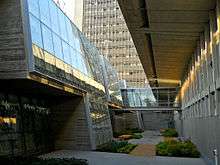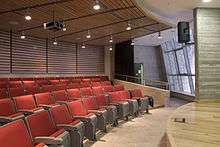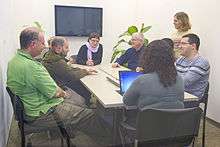Younes and Soraya Nazarian Library, University of Haifa
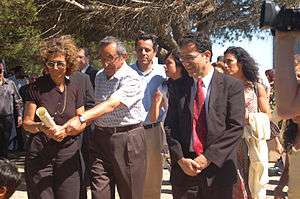
The University of Haifa's Younes and Soraya Nazarian Library is a central academic library, among the largest in Israel. It is one of the most progressive Israeli libraries in the realm of services and technology and library information systems.
From its founding in 1963, the Library has operated under one roof and is managed by a central administration. The Library offers academic information expertise for locating the wide range of material in its holdings and accessible via the Internet. The Library's role in the University's academic activity is based on professional specialization, which enables provision of information services in a wide variety of disciplines and information types.
The Library devotes resources to the development, preservation and digitization of special collections, such as dissertations, research publications, historical photographs of the Land of Israel, and archives of theatrical and performing arts. The collections, which are compiled and displayed in the "Digital Media Center", contribute to instruction and research in the University and beyond. Special emphasis is placed on ensuring accessibility in both the short and long term to the academic community and to the general public interested in matters of heritage preservation. An additional distinctive project is the production of the "Index to Hebrew Periodicals," a database of Hebrew-language articles and periodicals.
The Collection
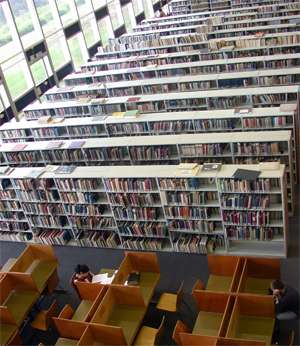
The Library collection comprises over two million items, including books and periodicals (in printed and digital formats), online databases in a variety of disciplines, maps and other cartographic material, films, audio recordings, pictures and archival material. All Library items may be searched and retrieved by means of "OneSearch" - a unified search box in the Library web site.
The Library's central collections include:
- General Collection – Most books are located in this open-shelf collection, and may be borrowed for two weeks.
- Reserves Collection – Numbers over 15,000 items, including: books for instructional use transferred to the collection by request of lecturers; a collection of psychological evaluation tests; and lecturers’ private books made available for student use. Most items in this collection may be borrowed for three days, some for one night only, and some are for in-house use.
- Periodicals Collection – This collection is divided into Loazi (i.e., non-Hebrew) titles, Hebrew titles and microforms. Periodicals may be borrowed for one week, by University staff members and Ph.D. students only. As of 2011, the Periodicals Collection held over 45,000 titles, including over 20,000 electronic journals.
- Media Collection –Holds audio-visual library materials, such as video, audio, music scores, discs, maps, satellite images, aerial photography, atlases, globes and historical maps. Along with these items are the tools enabling use of non-print material (stereo, video and DVD systems). In addition, there are special collections of books in the fields of art, photography, geography, environmental studies, music, archeology and cartography, as well as relevant printed material accompanying the non-print collections.
- Law Collection –Contains print and electronic materials, including legal literature from Israel and other countries: books, periodicals and legal encyclopedias. There are also reserve books, required readings for courses in the Law Faculty, by request of the lecturers; Israeli and foreign legislation and court decisions; and legal databases.
- Psychological Test Collection – Contains questionnaires and assessment instruments in a variety of fields, such as psychology, occupational therapy, physiotherapy and learning disorders. To facilitate development of the collection, the Library maintains ongoing contact with the various departments that make use of it. In addition, every questionnaire in dissertations – whether original, translated or adapted – is cataloged.
- Dictionary Collection – Includes dictionaries for many languages, which may be borrowed only for the purpose of examinations.
- Children’s Literature Collection – Holds about 22,000 books for leisure and informational reading, some 20,000 in Hebrew and 2000 in Arabic. The books may not be borrowed. Various activities in the areas of information literacy and encouragement of reading take place in the collection, for public-school and special-education pupils. The “Subject Index to Children’s and Youth Literature,” developed by the Library, makes it possible to search the collection by topic.
- Rare Books Collection – Contains over 3000 books, including special items that can no longer be purchased, books issued in limited editions, and books that are important due to their binding. Among the items in the rare books collection are works of Judaica, single pages from the Geniza, and Spinoza’s “Theological-Political Treatise,” including the author’s handwritten notes.
- Abba Khoushi archive – Holds many documents, lectures, protocols, pictures, and some personal items of Abba Khoushi from the years 1919-1969, which accumulated during his years in Israel as a public figure and party activist, as secretary of the Haifa Workers’ Council and mayor of Haifa from 1951-1969.
In addition to the above, varied collections of digital photographs, as well as the Database for Israeli Theater Archives, are accessible through the Library’s “Digital Media Center.”
Reader Services
As of 2012, some 160 computer stations are available to Library visitors for searching and retrieving information. The Library’s resources are available to the University community from off-campus as well. The Library has several helpdesks: Circulation and Interlibrary Loan; Reference; Reserves-Media and Periodicals. All helpdesks are concentrated in the entry level.
Users may also get assistance from the remote reference service, including replies via electronic mail, telephone and online conversations (“chat”). The Library also provides a service for photocopying, scanning and color printing, CD burning and document binding. Within the Library building there is access to wireless Internet.
There is free admission to the Library for visitors, including high-school students from 10th grade and up. Most Library collections are freely accessible. There is a charge for requesting assistance from the librarians for locating materials.
Location and Structure of the Library Over the Years
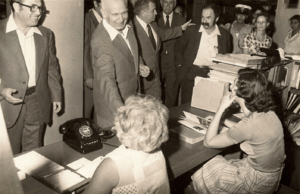
The Library’s location has changed over the years since it first opened in 1963, in the High School in Edelstein House on Y.L. Peretz Street in the Hadar HaCarmel neighborhood.
In the mid-1960s the Library – in the framework of the “University Institute of Haifa” - moved to a new location in the Haifa city school “Ironi Heh”, on Bikurim Street in Hadar HaCarmel. From 1969 until summer 1973 the Library was temporarily transferred to the upper floor of the Multi-Purpose Building on the new University campus.
In the early 1970s, construction of the Library in its current location commenced, as part of the project for establishing the University, designed by Oscar Niemeyer. In keeping with the architect’s conception of a “university under one roof,” the Library was founded as a central library serving all the faculties, constituting an academic center where people from varied disciplines would interact for mutual enrichment.
Professor Shmuel Sever, the Library’s director at the time, devoted several months to planning a modern, large library that would serve well into the future. Architect Shlomo Gilad translated his concepts and vision into architectural plans. Oscar Niemeyer designed the building in which the Library is located in the style of “Brutalistic architecture,” characterized by building with bare concrete in both simple and compound forms to create broad, open spaces that facilitate interior division and future expansion. This approach was common between the 1950s and mid-1980s, due to the influence of Le Corbusier.
The planning and construction work continued several years, and as luck would have it, concluded just at the unexpected outbreak of the Yom Kippur War. Despite the constraints and the lack of male workers for putting up shelves, maintenance and carrying loads, Prof. Shmuel Sever requested that the Library move to its new quarters as scheduled. And in fact, after detailed planning and despite the severe shortage of workers, librarians and books alike were transferred to the new location. Readers could now make use of a large, high-ceilinged reading room (which was said to be, at the time, the largest in the Middle East), whose eastern façade was composed entirely of windows facing onto the splendid view of Haifa Bay. The reading room itself held tens of work tables and chairs, the angle of whose backrests had been selected from several models by a poll of readers.
The books themselves were housed in galleries on the Library’s four levels. Broad corridors, stretching from east to west in the building, ensured maximal illumination. An explicit order from architect Gilad forbade closing these corridors, lest the daylight be blocked. New, brown carpets added warmth to the Library, and wood paneling on shelves and walls softened their grayish color.
It seemed, at the time, that the bookshelves would last forever, that the Library had no boundaries, and was destined to serve its patrons for many years. In fact, the Library that Niemeyer designed fulfilled its purpose for over thirty years. But at the beginning of the 21st century, the Library found itself too small and outdated to accommodate its growing collections and the advanced services and technologies it provided. It was not equipped to respond to changing research and teaching needs and its patrons’ expectations of an inviting, friendly environment.
Prof. Baruch Kipnis, director of the Library from 2001-2005, initiated the idea of expanding and renovating the Library according to the planning principles that he set forth and the architectural program that he prepared along with the Library staff. His persuasive efforts succeeded in obtaining the agreement of the University’s administration to support the idea of expansion and renovation.
In 2002, an architectural competition took place based on the principles and program that had been formulated. Architect Asaf Lerman was selected to carry out the planning and supervise the construction of a new wing. The project of erecting the building received impetus following receipt of a generous donation from the Nazarian family [see below]. Library director Oren Weinberg oversaw the construction work until its completion.
Lerman selected fashionable materials such as bare concrete, glass and wood, and planned the new wing in a neo-modernistic spirit, creating a successful dialog with the old wing built in the modernistic style of Niemeyer. Construction was completed in 2010. For his planning of the new wing, Architect Lerman was selected as one of five finalists for the 2010 Rechter Prize in architecture.
Renovation of the original library wing, including reorganization of the Library entrance, interior spaces, study corners, a central service area and circulation desks, was completed in June 2012.
The Donation that Resulted in the Library’s Expansion, 2007-2012
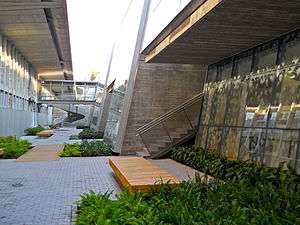
In 2007, Soraya and Younes Nazarian, leading members of the community of expatriate Iranian Jews in Los Angeles, made a generous donation to the University for the purpose of renovating and expanding the Library, including construction of a new wing.
The Nazarians are known for their philanthropic activities on behalf of the community in a variety of fields, including the arts, health and the development of institutions of higher education in the United States and Israel. The couple donates to educational institutions in Israel out of a conviction that education is essential for Israel’s future. They believe that investment in education will improve not only the personal condition of each citizen, but also the economic situation of the whole nation.
In June 2007, Younes Nazarian received an honorary doctorate during the meeting of the University’s Board of Governors, in recognition of his donation and commitment to the State of Israel and to Jews the world over.
The dedication ceremony for the new wing, officially named the “South Wing”, took place on 31 May 2011, at which time the Library was renamed the “Younes and Soraya Nazarian Library, University of Haifa.” On June 3, 2012 – during the 40th annual meeting of the University’s Board of Governors and in the presence of the donors - an additional festive dedication ceremony was held to mark the conclusion of the Library renovation.
Technological Development in the Library – From Card Catalog to “OneSearch”
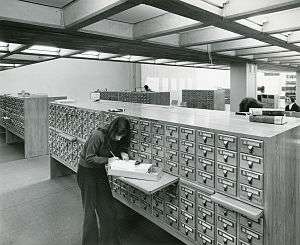
From the time the Library opened in the early 1960s, it has developed in keeping with changes in the technological environment. A central change was the transition from use of the Dewey Decimal classification system to that of the Library of Congress, which was at the time unknown in Israel. This transition was led by Prof. Elhanan Adler and Aviva Shichor. Additional milestones were the computer revolution that the Library underwent from the end of the 1970s and the introduction of the Internet at the beginning of the 1990s.
Technological developments influenced the means of storing information, the Library catalog and databases on the one hand, and retrieval of information, on the other. The many transformations in the professional work of librarians and information specialists and in the use of the Library and its resources included remote access to the Library catalog and bibliographic databases, electronic periodicals and books, and remote reference services (by means of telephone, email and live conversation – Chat).
The influence of technological advancement is evident throughout the Library. The traditional card catalog was replaced in the 1980s by a computerized catalog, which itself evolved over years and became accessible via the Internet. Access to many databases was transformed from a local CD network to online formats. Most periodicals were converted to digital format, accessible from anywhere at any time. Collections of slides, photographs and products of University research were scanned and merged into the Digital Media Center. Over time, electronic books constitute an ever larger proportion of the Library’s collection.
A unique project of the Library is the “Index to Hebrew Periodicals”, a multi-disciplinary tool that provides users access to academic articles as well as business and popular ones. The Index contains citations to hundreds of thousands of articles from selected periodicals, collections and daily newspapers in many fields: Judaica, literature, education, history, archeology, the arts, architecture, medicine, law, agriculture, nature, science, technology, society and the nation. Since its inception in 1977, the indexing project was transformed over the years from a printed format to a computerized one, and was eventually incorporated into the Library services available via the Internet.
With the opening of the 2009-2010 academic year, the Library’s online services were unified under the “OneSearch” portal – based on the Ex Libris “Primo” system - providing a single entry point to all the Library’s resources. The Library was the first in Israel to adopt Primo and to develop and integrate a Hebrew interface (graphic design and text) for the portal, in line with the expectations and requests of users.
Assessment and Measurement Activities
Since 2007, the Library has regularly carried out assessment and measurement activities aimed at determining the quality of its services based on user feedback. For this purpose, a number of activities are performed, including surveys, audits and focus groups. These examine varied aspects of the Library’s services: the physical environment, identifying user needs, collection evaluation, evaluation of user interfaces to the Library’s content and services – both within the Library and via remote access.
Once every three years the Library conducts a "LibQUAL survey". LibQUAL, established and managed by the Association of Research Libraries (ARL) in the United States and Canada, is part of an international survey that has so far been carried out in more than 1000 academic libraries worldwide. The University of Haifa Library is the first Israeli library to participate, and assisted in developing the Hebrew version of the survey.
The Library maintains a dedicated website that publicizes all the evaluation and measuring activities, the results of surveys, and actions taken by the Library in light of the results.
Library Directors Over the Years
- Moshe Yogenstein – 1963-1969
- Prof. Shmuel Sever – 1969-2000
- Prof. Baruch Kipnis – 2000-2005
- Oren Weinberg – 2005-2011 Academic directors: Prof. Chaya Bar-Yitzchak, Prof. Yaakov Barnai, Prof. Yoav Gelber
- Pnina Erez – February 2011 – Academic director: Prof. Yossi Ziegler
Photo Gallery
|
Additional Reading
- Sever, Shmuel. Establishment and Management of the University of Haifa Library, 1969-2000 : Personal Summary. Haifa, [n.p.] 2000 (In Hebrew)
- Adler, Elhanan and Shichor, Aviva. Cataloging : Fundamentals and Rules. Jerusalem: Center for Public Libraries in Israel, 1995. (In Hebrew)
External links
- Official site (English) (Hebrew)
- IHP- Index To Hebrew Periodicals
- Library Digital Center - DMC
- Library assessment
- Support the Library
